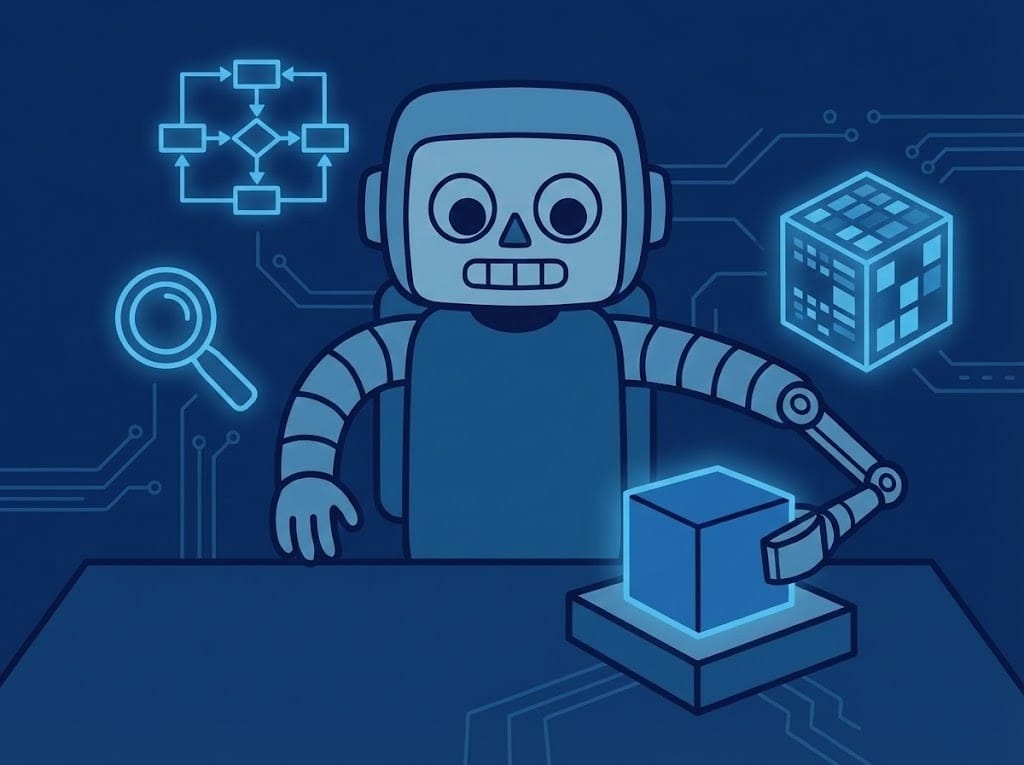The Best LLMs for Coding: An Analytical Report (May 2025)

As of May 2, 2025, leading coding LLMs include OpenAI’s o3/o4-Mini series (≈80–90% Pass@1, 128–200 K context, balanced speed/cost), Anthropic’s Claude 3.7 Sonnet (≈86% HumanEval, 200 K context, top real-world task performance), Google’s Gemini 2.5 Pro (≈99% HumanEval, 1 M+ token window, superior reasoning), and open-source contenders like DeepSeek R1 (strong reasoning/math, 128 K+ context, low‐cost API) and Meta’s Llama 4 Maverick (≈62% HumanEval, up to 10 M context, free self-hosting).
Table of Contents
- Introduction
- Evaluation Criteria: Benchmarking the Coders
- Top Models Overview
- Standout Features & Capabilities Deep Dive
- Conclusion
Introduction
Large Language Models (LLMs) have profoundly reshaped the software development landscape by May 2025. Evolving beyond basic code completion, these sophisticated AI co-pilots now debug complex code, refactor entire codebases, generate comprehensive documentation, translate between programming languages, and even assist in high-level system design. This has led to a significant boost in developer productivity and opened up new possibilities in software creation.
However, this rapid integration of LLMs introduces new challenges. Concerns regarding the quality, maintainability, security, and even the ethical implications of AI-generated code are rising. Recent studies indicate a correlation between widespread LLM adoption and decreased stability in software releases. This highlights the critical need for establishing best practices, conducting thorough assessments, and fostering a nuanced understanding of LLM capabilities. The potential for "automation bias" – over-reliance on AI-generated code without proper human review – poses a significant risk.
Hey! Want to compare model performance yourself?
PromptLayer is specifically designed for capturing and analyzing LLM interactions. Providing insights into prompt effectiveness, model performance, and overall system behavior.
With PromptLayer, your team can:
- Use Prompt Versioning and Tracking
- Get In-Depth Performance Monitoring and Cost Analysis
- Detect and Debug errors fast
- Compare Claude 3.7 and o1 side-by-side
Manage and monitor prompts with your whole team.
Objective & Scope
This report provides a comprehensive analysis and data-driven comparison of the leading LLMs specifically designed for coding tasks as of May 2, 2025. We aim to identify and evaluate models that offer the optimal balance of code generation accuracy, logical reasoning capabilities, contextual understanding within large codebases, efficiency in terms of speed and resource consumption, and seamless integration into existing developer workflows. Our analysis encompasses both prominent commercial models and competitive open-source alternatives, leveraging quantitative benchmarks, qualitative user insights from developer communities, and expert opinions.
Navigating the Landscape: Open vs. Closed Source
The LLM ecosystem for coding is broadly divided into commercial (closed-source) and open-source models. Commercial offerings from industry giants like OpenAI, Anthropic, Google, and Microsoft are typically accessed through APIs or subscription services. These models often represent the cutting edge of performance and feature sets. However, they come with associated usage costs, limited transparency into their inner workings, and the potential for vendor lock-in.
Open-source models, championed by organizations like Meta, DeepSeek, Alibaba, and Mistral AI, offer greater transparency, full control over deployment and customization, and the freedom from recurring subscription fees. While historically lagging behind commercial models in peak performance, recent advancements have closed the gap significantly. Top-tier open-source LLMs now deliver competitive performance, making them increasingly attractive alternatives for organizations prioritizing cost-effectiveness, data privacy, and full control over their development pipeline. Furthermore, the open-source nature fosters community-driven development and allows for rapid iteration and customization tailored to specific needs.
Evaluation Criteria
Why Benchmarks Matter (and Their Limits)
Objective comparison of coding LLMs necessitates standardized benchmarks. However, relying solely on static benchmarks may not fully capture the multifaceted nature of real-world software development. Older benchmarks are also susceptible to data contamination – where training data overlaps with test data – leading to inflated scores and inaccurate performance representations. This report employs a holistic evaluation approach, combining results from static benchmarks like HumanEval and MBPP with dynamic leaderboards tracking performance on evolving tasks, simulations of real-world coding scenarios (e.g., debugging, refactoring), and qualitative feedback gathered from developer surveys and online forums.
Key Coding Benchmarks Explained
- Function-Level Correctness:
- HumanEval: Evaluates the ability to generate functionally correct Python code snippets from docstrings. Leading models now achieve impressive Pass@1 scores (the percentage of tasks solved correctly on the first attempt), with some exceeding 90%. Improvements in prompt engineering and fine-tuning techniques contribute to this high accuracy.
- MBPP (Mostly Basic Python Problems): Tests understanding of fundamental Python programming concepts. High scores on MBPP indicate a model's proficiency in handling common coding tasks.
- Real-World Task Simulation:
- SWE-Bench: Assesses the capability to solve real-world software engineering issues sourced from GitHub repositories. This benchmark reflects the practical applicability of LLMs in addressing common coding challenges.
- BigCodeBench: Focuses on evaluating task automation through code generation, involving diverse function calls and complex instructions. Performance here indicates a model's ability to handle intricate coding scenarios.
- LiveCodeBench: Aims for a comprehensive and contamination-free assessment across a range of coding tasks, including code generation, self-repair of faulty code, prediction of test outputs, and code execution in a controlled environment. This benchmark emphasizes robustness and reliability.
- SQL and Database Interaction:
- Spider 2.0: Employs complex SQL queries against databases derived from real-world applications, requiring advanced logical reasoning and understanding of database schema to generate correct SQL queries. High performance on Spider 2.0 demonstrates proficiency in database interactions, a crucial skill for many software applications.
Core Evaluation Metrics & Factors
This report considers the following key metrics and factors in its evaluation:
- Accuracy & Correctness: Measured by Pass@1 scores on benchmarks and functional correctness of generated code in real-world simulations.
- Reasoning & Problem Solving: Crucial for tackling complex coding challenges, debugging intricate issues, and designing efficient algorithms. Assessed through benchmarks like SWE-Bench and Spider 2.0.
- Context Window Size: The extent of information a model can process simultaneously, impacting its ability to understand large codebases and complex tasks. Measured in tokens (words or sub-word units), ranging from standard (16k tokens) to massive (1M+ tokens).
- Speed & Efficiency:
- Latency (Time To First Token - TTFT): Measures the responsiveness of the model, indicating how quickly it begins generating code after receiving a prompt.
- Throughput (Tokens per Second - TPS): Measures the speed of code generation after the initial response. Higher throughput signifies faster code completion.
- Cost: Varies significantly across models, encompassing factors like per-token charges, subscription fees, and the computational resources required for self-hosting open-source models.
- User Feedback & Preference: Qualitative data gathered from developer communities, online reviews, and surveys provides valuable insights into practical usability, ease of integration, and overall satisfaction with different LLMs.
- Integration & Tooling: Support for IDE plugins, compatibility with popular AI coding assistants (e.g., GitHub Copilot, Tabnine), and availability of robust APIs for seamless integration into existing development workflows are critical factors for practical adoption.
Top Models Overview
Leading Commercial Models
- OpenAI (GPT-4o, o3/o4 Series):
- Performance: Strong general-purpose performers with high HumanEval scores and strong MBPP performance. The 'o' series enhances reasoning capabilities.
- Features: Native multimodality, adjustable reasoning effort levels, mature ecosystem.
- Anthropic (Claude 3.7 Sonnet /):
- Performance: Excels on complex coding tasks and real-world benchmarks like SWE-Bench.
- Features: "Extended Thinking" mode, large 200k token context window, focus on AI safety.
- Google (Gemini 2.5 Pro / Flash):
- Performance: Leader in reasoning and handling massive context.
- Features: Massive 1 million+ token context window, "thinking" capabilities, multimodal input.
Leading Open Source Models
- DeepSeek (R1, V3, Coder V2):
- Performance: Strong focus on reasoning and coding, with excellent performance on math benchmarks.
- Features: Mixture-of-Experts (MoE) architecture, generous context windows, permissive licenses.
- Meta (Llama 4 Scout/Maverick, Llama 3.3 70B):
- Performance: Llama 4 series introduces models with massive context windows. Llama 3.3 70B is a strong, balanced model.
- Features: MoE architecture, large community, fast inference speeds.
- Alibaba (Qwen 2.5 Coder / QwQ-32B):
- Performance: Proficiency in Python and effective handling of long context.
- Features: Instruction-tuned, supports multiple languages, can generate structured outputs.
Comparative Snapshot of Top Contenders
| Model Name | Developer | Type | HumanEval (Pass@1) | SWE-Bench (% Resolved) | LiveCodeBench (Pass@1) | MBPP (Accuracy) | Context Window | Cost Tier | Standout Feature/Strength |
|---|---|---|---|---|---|---|---|---|---|
| Claude 3.7 Sonnet | Anthropic | Commercial | ~86% | ~70% | ~50% | N/A | 200k | High | Leading real-world coding, Reasoning Mode |
| OpenAI o3 (high) | OpenAI | Commercial | ~80% | ~69% | ~79% | N/A | 128k+ | Very High | Top-tier reasoning, Strong Aider performance |
| Gemini 2.5 Pro | Commercial | ~99% | ~64% | ~70% | N/A | 1M+ | High | Massive context, Strong reasoning/math | |
| OpenAI o4-Mini (high) | OpenAI | Commercial | N/A | ~68% | ~73% | N/A | 200k | Medium | Top LiveCodeBench, Balanced reasoning/speed |
| GPT-4o | OpenAI | Commercial | ~90% | ~33-55%* | ~30% | ~90%** | 128k | Medium | Speed/Cost balance, Multimodal, Ecosystem |
| DeepSeek R1 | DeepSeek AI | Open Source | ~37%*** | ~49% | ~64% | N/A | 128k+ | Low (API) | Strong reasoning/math (open), Efficiency |
| Llama 4 Maverick | Meta | Open Source | ~62% | N/A | ~41-54% | ~78% | 10M (claim) | Free (OS) | Massive context potential, Creativity |
| Qwen 2.5 Coder (32B) | Alibaba | Open Source | N/A | ~31% | N/A | N/A | 128k | Free (OS) | Strong Python (local), Long context handling |
*Note: SWE-Bench score varies significantly depending on GPT-4o version and evaluation setup. GPT-4.1 shows much higher scores.
**Note: High MBPP scores often achieved using agentic frameworks (e.g., CodeSim with GPT-4o).
***Note: HumanEval score for early DeepSeek R1; later versions/V3 likely higher.
N/A: Score not readily available or consistently reported for this specific metric/model combination in reviewed sources.
Cost Tier: Relative comparison (Free (OS), Low, Medium, High, Very High) based on API pricing or infrastructure needs.
Standout Features & Capabilities Deep Dive
The Reasoning Renaissance
Coding LLMs are increasingly emphasizing sophisticated reasoning capabilities, moving beyond simple pattern matching.
- Integrated Hybrid Modes: Claude 3.7 Sonnet features an "Extended Thinking" mode for deeper analysis.
- Adjustable Reasoning Levels: OpenAI's 'o' series allows users to tune the model's computational investment.
- Dedicated Reasoning Models: DeepSeek AI positions its DeepSeek R1 model as a reasoning-focused architecture.
Context is King (Handling Large Codebases)
The ability to process and understand vast amounts of context is a major differentiator.
- Google's Gemini 2.5 Pro offers up to 1 million tokens.
- Meta's Llama 4 Scout and Maverick claim a theoretical capacity of 10 million tokens.
The Performance Triangle (Speed vs. Cost vs. Accuracy)
Developers navigate trade-offs between model speed, cost, and accuracy.
- High Speed / Low Latency: GPT-4o, Gemini Flash variants, Claude 3.5 Sonnet, and Llama 4 Scout.
- High Accuracy / Deep Reasoning: OpenAI's o3, Claude 3.7 Sonnet, and Gemini 2.5 Pro.
- Cost Efficiency: Open-source models, tiered commercial offerings, and specific providers like Amazon Nova.
Developer Experience & Ecosystem
The practical utility of an LLM depends on its integration into existing developer workflows.
- AI Coding Assistants: GitHub Copilot, Tabnine, Sourcegraph Cody, Cursor, Aider, Amazon Q Developer.
- IDE Integration: Seamless integration into Visual Studio Code, JetBrains suite, and other editors.
- Multi-LLM Support: Tools like Sourcegraph Cody and Perplexity Pro allow developers to switch between models easily.
Open Source Momentum
The open-source LLM ecosystem offers increasingly viable alternatives to proprietary systems.
- Transparency and Control: Access to model weights and architectures.
- Cost-Effectiveness: Self-hosting can be cheaper in the long run.
- Community and Innovation: Active communities contribute to development.
Conclusion
Synthesis of Findings
As of May 2025, the landscape of LLMs for coding is characterized by intense competition and increasing specialization.
- Top Commercial Performers: OpenAI's 'o' series and Google's Gemini 2.5 Pro lead in complex reasoning. Claude 3.7 Sonnet excels in real-world challenges.
- Top Open Source Contenders: DeepSeek's R1 and V3, Meta's Llama 4 series, and Alibaba's Qwen 2.5 Coder offer strong alternatives.
About PromptLayer
PromptLayer is a prompt management system that helps you iterate on prompts faster — further speeding up the development cycle! Use their prompt CMS to update a prompt, run evaluations, and deploy it to production in minutes. Check them out here. 🍰



